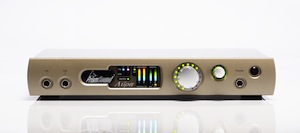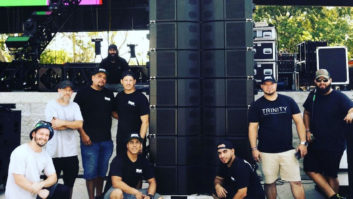
The Lyra 2 steps beyond the Lyra 1 boundaries to provide many great new features.
One of the hallmarks of the Prism Sound brand has been exceptionally transparent A/D and D/A converters. Products in the company’s recent USB interface line have varied in numbers of I/O channels provided, but in each case they offer high-quality mic preamplifiers, digital I/O and monitoring facilities. The second-generation release of the Lyra-family USB audio interface is its most affordable option, built on a foundation of features that should please a variety of users.
The build quality of the Lyra 2 sets it apart from your typical USB interface. Its solid steel chassis and steel wraparound cover panel sturdily and elegantly house the internal electronics.
The front panel features a large, multifunction rotary encoder with green LED indicators surrounding it, an analog headphone level adjustment knob that is also wrapped in green light, and a status display in the middle of the unit featuring two multifunction stereo meters. Using a variety of illuminated segments and changing colors, they indicate level present at the digital or analog inputs or outputs. At first, they seemed more showy than useful, being that they only have four segments. But once I got to know them and was more familiar with the way that their colors changed, they became useful at a glance. There are also indicators showing which connector is assigned to each of the analog inputs, and a clock status indicator for working with digital I/O. Additionally, two ¼-inch instrument inputs and a headphone jack can be found on the front panel.
Getting Connected
Back panel connections include two XLR inputs, two ¼-inch TRS inputs, four ¼-inch TRS outputs, a coaxial digital input connector and one output, each on RCA type connectors, plus a Toslink input and output, BNC word clock input and output connectors, a B-Type USB connector for Mac or PC interface, a standard 6A IEC power connector, and an RJ45 connector with no current use, but added with the future in mind.
Each of the two analog inputs can be fed by either the front panel ¼-inch instrument connector, the rear panel ¼-inch TRS line level connector, or the XLR mic connector. The input can be automatically selected by Lyra, based on a preset hierarchy, or manually selected with no more than two analog inputs available simultaneously. The RCA connector can operate as a standard 2-channel S/PDIF input, or can accept an AES3 stereo pair. An XLR-to-RCA adapter is provided. Alternatively, the Toslink connector can act as a stereo S/PDIF input or can accept eight channels of ADAT optical input or four channels of high-res ADAT S/MUX signal.
Much like the input section, the co-ax digital output can behave as a S/PDIF output or AES3 output using the second provided adapter. The Toslink can also serve as a S/PDIF output or each variety of ADAT. The whole digital I/O is one of the major points of improvement since the original Lyra. The Lyra 1‘s Toslink connector could only be used for S/PDIF purposes and it had no coaxial connector at all. The fact that Prism Sound included the alternative connector and then went on to cover nearly every modern digital standard is impressive.

The digital and analog outputs are always active. The original Lyra had only two analog outputs, so this is another big improvement. All the TRS connectors, both input and output, are fully balanced but can also work with unbalanced signals. The unit will automatically detect and compensate when necessary. The headphone output serves as a supplemental path, potentially carrying a signal unique from the other outputs. The interface can use the Mac OS CoreAudio driver, allowing plug-and-play operation without needing software to be installed. In fact, the Lyra 2 can work without a computer connected at all, behaving as a high-quality AD/DA converter, stand-alone mic preamp or monitoring device.
Software Control
The Prism Sound USB Audio software is powerful and offers an impressive amount of information and functionality. I didn’t find it to be the most intuitive software-based control panel I’ve ever encountered. It definitely took a few trips to the manual to wrap my head around what exactly was going on, and how to make it fit my workflow. There is a good amount of flexibility regarding how zero-latency inputs can be monitored in combination with signals returning from recording software. Learning the way things were labeled and organized took a little getting used to, but once I did, I appreciated the implementation and the headroom of the clean precise digital mixers building these combined signals.
The top part of the control panel addresses overall settings, like establishing a sample rate and sync source. The sample rates range from 44.1 kHz to 192 kHz with every standard rate in between. Changing the sample rate in the host application will automatically be reflected by a change in the Lyra’s control panel. Likewise, changing the clock source from Local to instead lock to embedded clock signals arriving at the digital input or word clock input automatically changes the sample rate of the Lyra 2. The newly added BNC word clock I/O is a welcome addition and would be a fitting sync source for an entire studio. The output can pass standard wordclock, or I suppose if you’re interfacing with older Digidesign interfaces you’ll be pleased to find a 256x SuperClock setting. The Lyra 2 also offers high-quality SRC for all of its digital inputs and outputs.
In Use
I started out recording bass through the instrument input, and acoustic guitars, ukulele, and vocals with the built-in mic preamps. The bottom end was fantastic; the top end was clear and detailed. Other A/D converters tout their transparency, but when you actually hear them, they certainly have a personality that hypes certain frequencies. These Prism Sound pre’s and converters are truly transparent and clean.
Everything I recorded with them simply sounded like reality. I had little bits of Foley that I needed to record for a film, so I couldn’t imagine a more perfect tool for capturing low-level sounds. I needed the sound of someone pounding on a wall next door, and someone pounding back in the same room. The detail and transient response sounded so strangely real, it was fantastic.
Having to pop open the software control panel to make level adjustments was a little annoying. I have never been a huge fan of adjusting a mic pre with a mouse. When it is necessary, though, I feel like a software knob seems, somehow, preferable to a software fader for input gain adjustment. However, considering that the large, continuously variable rotary control on the front panel seems to be a software control, I think it would be nice if a button in the control panel could map the input gain to this knob. I spent a lot of time running the AES3 output of the Lyra 2 to a monitor controller anyway, so that knob was often wasted. Mapping the input gain to it, especially if the inputs could be set for linked stereo operation, would circumvent the need to return to the software control panel every time a gain adjustment is necessary.
New and Improved?
Because of the price, the Lyra 2 is obviously not going to be for everyone. But if you’re looking for the absolute best stereo recording interface on the market, this could be it. The sound is simply perfect, and any minor complaints I have about the software certainly take a back seat to the superior sound quality. For A/D conversion of analog masters, mixdowns from analog consoles or even archival vinyl transfers, especially with the newly added RIAA de-emphasis, you’d be hard pressed to find a better solution. For mastering, there is just enough I/O to output a track, process through analog gear, return through impeccable A/D converters, and monitor sample-rate-converted and dithered-down signals through another analog output. For any of these applications, the Lyra 2 would be worth every penny.
Brandon Hickey is an independent engineer who works on independent films and music projects.
Product Summary
COMPANY: Prism Sound
PRODUCT: Lyra 2
WEBSITE:www.prismsound.com
PRICE: $3,225 street
PROS: Incredible sound and incredible array of features.
CONS: Relies greatly on software control panel rather than hardware controls.
Try This
When connecting two digital devices using a digital connection like AES/EBU, S/PDIF or ADAT, a common practice is to unify the sample rates of the two devices by relying on the embedded clocking signal that is transmitted through the common digital audio connection. It is important to note that clock signals transmitted between packets of audio data are typically less steady than stand-alone word clock signals, so when a dedicated word clock connection is offered, it is wise to use it.







